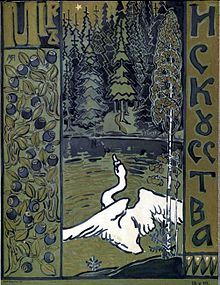Mir iskusstva
[1] From 1909, several of the miriskusniki (i.e., members of the movement) also participated in productions of Sergei Diaghilev's Ballets Russes company based in Paris.The theoretical declarations of the art movements were stated in Diaghilev's articles "Difficult Questions", "Our Imaginary Degradation", "Permanent Struggle", "In Search of Beauty", and "The Fundamentals of Artistic Appreciation" published in the N1/2 and N3/4 of the new journal.Like the English Pre-Raphaelites before them, Benois and his friends were disgusted with anti-aesthetic nature of modern industrial society and sought to consolidate all Neo-Romantic Russian artists under the banner of fighting Positivism in art.Bakst and Benois revolutionized theatrical design with their ground-breaking decor for Cléopâtre (1909), Carnaval (1910), Petrushka (1911), and L'après-midi d'un faune (1912).Apart from three founding fathers, active members of the World of Art included Mstislav Dobuzhinsky, Eugene Lansere, and Konstantin Somov.They published guide-books on Pavlovsk, St Petersburg, Hermitage Museum, an exquisite edition of The Bronze Horseman with illustrations by Benois and many more.


Boris KustodievIgor GrabarNicholas RoerichEugene LancerayIvan BilibinAnna Ostroumova-LebedevaAlexandre BenoisHeorhiy NarbutKuzma Petrov-VodkinKonstantin SomovMstislav DobuzhinskymagazineSergei DiaghilevBallets RussesDmitry FilosofovLéon BakstEugene LansereStieglitz Museum of Applied ArtsSaint-PetersburgSt. PetersburgPeredvizhnikiArt NouveauMaria YakunchikovaImperial Academy of ArtsMoscowValentin SerovKonstantin KorovinZinaida SerebriakovaSergei Lednev-SchukinDmitry MitrohinSerge SudeikinNathan AltmanVladimir TatlinMartiros SaryanRussian avant-gardeJack of DiamondsThe Tale of the Golden CockerelPre-Raphaelitesindustrial societyNeo-RomanticPositivismfolk artrococoAntoine Watteauhumorouslyparodymarionettescarnavalpuppet theaterdreamsfairy-talesgrotesqueVeniceDiaghilevStravinskywatercolorgouacheinteriorstheatrical designCléopâtrePetrushkaL'après-midi d'un fauneMikhail VrubelMikhail NesterovIsaac LevitanPavlovskHermitage MuseumThe Bronze HorsemanRussian art and literary movementsAbramtsevo ColonyAcmeist poetrySecond Russian avant-gardeConceptualismConstructivismThe FiveRussian FuturismCubo-FuturismEgo-FuturismImaginismLieutenant proseMetarealismNatural schoolNew peasant poetsOberiuRayonismRussian postmodernismRussian symbolismSocialist realismSoviet nonconformismStroganov schoolSuprematismVillage proseAvant-gardeAbstract expressionismArt & LanguageConceptual artProto-CubismCubismFunctionalismBauhausGrosvenor SchoolDevětsilDivisionismFauvismImpressionismNeo-ImpressionismPost-ImpressionismColor FieldIncoherentsLyrical AbstractionMail artMinimalismMultidimensional artNeoplasticismDe StijlNeue Slowenische KunstNonconformismNouveau réalismeOrphismPerformance artPop artProcess artPurismTemporary artVorticismAcmeism